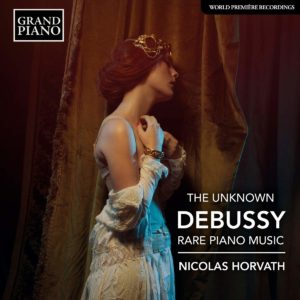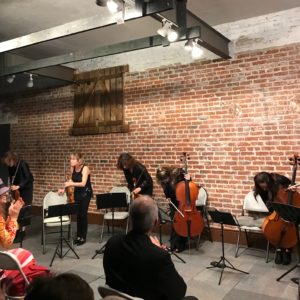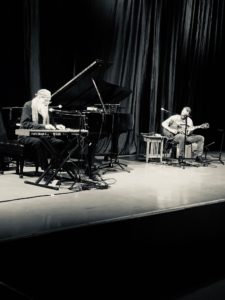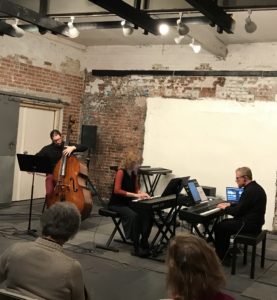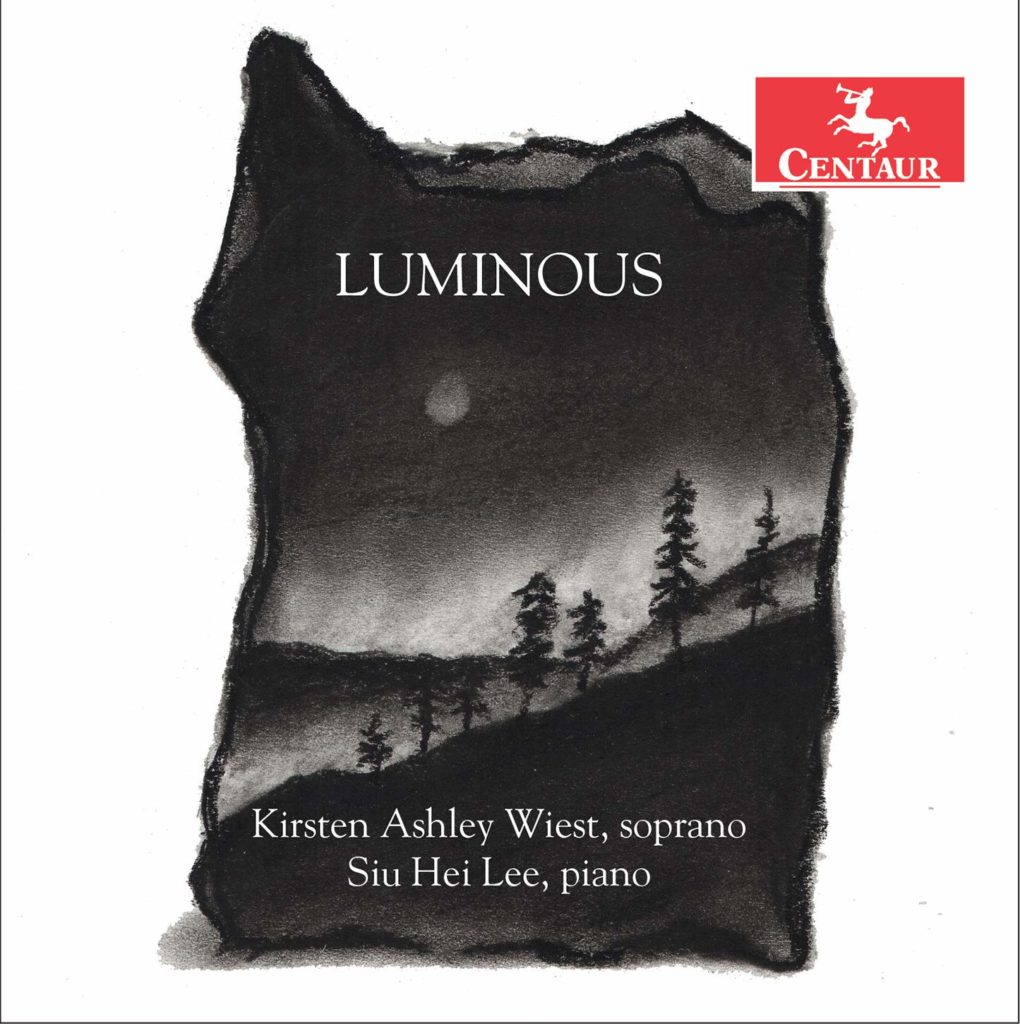
LUMINOUS
Kirsten Ashley Wiest, soprano
Siu Hei Lee, piano
Centaur Records
Centaur Records has recently released LUMINOUS, a new CD of contemporary art songs featuring coloratura soprano Kirsten Ashley Wiest, accompanied by pianist Siu Hei Lee. Three original pieces by composers Jeffrey Holmes, Jack Van Zandt and James Erber were written specifically for Ms. Wiest’s extraordinary voice and explore the eternal contrast of darkness and light. Also included is the technically challenging Mysteries of the Macabre by György Ligeti.
The opening piece, Fragments, by Jeffrey Holmes is a four-movement work based on Latin texts compiled by the composer. The first movement, “Horumque Visum Contegas”, opens with strong piano chords that are dark and brooding, like a blustering winter storm. The entry of the solo voice is nicely sustained and adds a touch of the mysterious. As the piano re-enters, a palpable element of tension is felt. The vocals are precisely balanced against the churning piano passages and the crescendo at the finish is both chilling and disquieting. The second movement, ”Fera Pessima” or ‘Wild Beast’, extends the sense of distress, with the voice dominating in the higher registers. There is primal drama here, yet Ms. Wiest’s voice propels the narrative with a radiant translucence and artful control.
“Stella Maris”, or ‘Star of the Sea’ is the third movement and the piano opening is more subdued. There are no crashing chords or strong gestures, and the soaring arc of the voice is calming, if somewhat tentative and suspenseful. The agitation and dynamic build towards the finish and the piano roils as if a turbulent sea. The vocals quietly trail off at the conclusion.
“Qui Lux es et Dies…”, or ‘Who Thou art the LIGHT and the Day,’ is the final movement, opening with a quiet string of piano notes, followed by simple, declarative chords. The voice enters with a questioning feel, and there is almost a sense of resignation in this. The piano gradually becomes more assertive, and the voice rises to dominate above the now stronger piano chords. With all the changes in dynamics and tension in vocal line, Ms. Wiest’s voice remains resolutely under control, never compromising her delicate, yet pure sound. Throughout its four movements, Fragments delivers a sharp sense of darkness and destiny and the interplay between the piano and voice is masterfully arranged and precisely performed.
The next piece is Phoenix, by James Erber, a two movement work with texts from love sonnets written by 16th century philosopher Giordano Bruno. In the first movement, “Unico augel del dol”, the opening piano line is halting and angular while the voice enters and soars above this with a beautiful melody. The feeling is uncertain and tentative in the piano but brightly confident in the vocals.
“You have fixed terms,
Of long life, and I have a short course”
The peculiar and independent piano line continues in the second movement, “Bench’a tanti martir” based on the second sonnet. The voice enters in a middle register, adding new colors and a warm expressiveness to the text. The piano accompaniment works with the vocals in a counter-intuitive way, there are no great chords or thick harmonies to surmount but there are some impressive leaps in pitch, all capably managed by Ms. Wiest. Towards the finish there is some lovely humming – thin, light tones are heard, with an almost electronic purity. The confidence in the vocal phrasings and the clear singing against the sometimes jagged piano passages makes this performance of Phoenix both elegant and impressive.
Apples and Time Crack in October, by Jack Van Zandt is next, a four-movement piece based on texts from Los Angeles-based poet Jill Freeman. The first movement, from which the entire work takes its title, opens with a rapid series of piano phrases and a strong entrance by the voice. Impressive vocal agility and precise pitch control are evident here while the piano is full of energy, like the wind on a blustery fall evening. The piano swirls and gusts below the soprano voice that sings knowingly of autumn secrets and vivid images.
“Who knows what witch
or wolf lies ‘round the
corner of November.”
“A Poem Sat”, the second movement consists of quiet piano chords and simple melody lines throughout. Somber and restrained, the vocals remain in check, and even the high notes and crescendos are refined and stately, without excess. This movement provides a fine contrast with the first, imparting a sense of calm and introspection. “The Nightingale” follows, and you can hear the active chattering of birds in the piano entrance. Smooth vocals glide over this, mostly in middle registers and only occasionally reaching for the heights. A brisk theme in the piano is heard when the text turns to “Children running, falling in streams calling ‘mother.’ Clearly this is music of a more innocent time. A singularly mechanical feeling is heard in the piano line as the text concludes:
“I must break
this beautiful
mechanical bird
before you wake.”
The final movement, “Helen’s Invocation”, is the piano version of an aria from A Thousand Ships, an opera by Van Zandt and Freeman inspired by the epic tale of Helen of Troy. Slow, ominous notes and chords bubble up from the lower registers of the piano at the beginning and the strong entrance of the voice adds a touch of mysticism. The rolling piano lines recall Homer’s ‘wine dark sea’ as the vocals become steady and purposeful, effectively drawing Helen into the center of the drama. Long, soaring vocal lines fly upward, and a sense of the heroic takes hold as the movement proceeds. The imagery in the music and the text are artfully combined, and the singing is both confident and agile.
The final track is Mysteries of the Macabre, by György Ligeti and this is probably the most abstract and vocally demanding piece on the CD. Mysterious whispering, rapping on the piano, vocalise and other unexpected sounds form the foundation of this piece. Sudden vocal jumps, disjointed rhythms and darting runs add to the overall complexity and pose formidable challenges to the performers. Ms. Wiest and Siu Hei Lee navigate all of this with assurance and style, however, and it is good to know such exceptional talent is part of our musical community.
Special mention should be made of the sound engineering by Alexandria Smith and the mastering by Talley Sherwood. The colors and nuances in Ms. Wiest’s voice are all clearly heard and a new appreciation of her gloriously translucent tones, precise dynamic control and purity of pitch are gained in this recording that might otherwise be missed in the concert hall.
LUMINOUS is available directly from Centaur Records as well as Amazon Music.
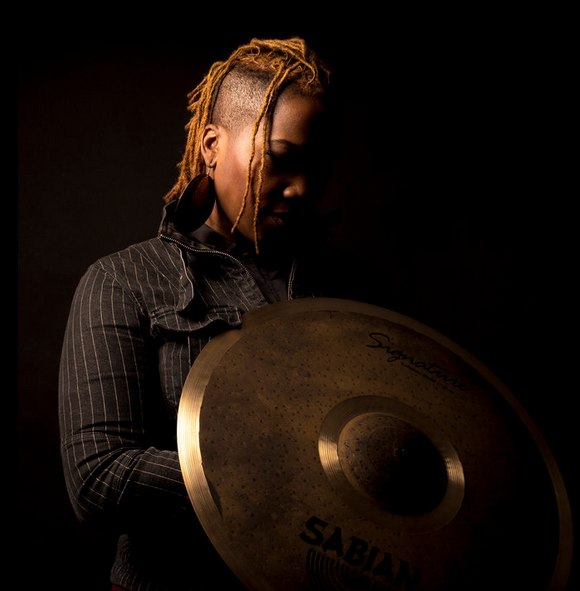
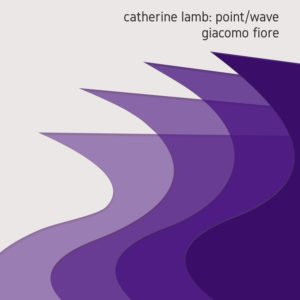
 Julian Bennett Holmes is the Sacred Music Coordinator of the St. Paul Chapel at Columbia University. He is an award winning composer, having studied with Lowell Liebermann and Richard Danielpour. Julian also teaches undergraduate courses at the Manhattan School of Music.
Julian Bennett Holmes is the Sacred Music Coordinator of the St. Paul Chapel at Columbia University. He is an award winning composer, having studied with Lowell Liebermann and Richard Danielpour. Julian also teaches undergraduate courses at the Manhattan School of Music. 
